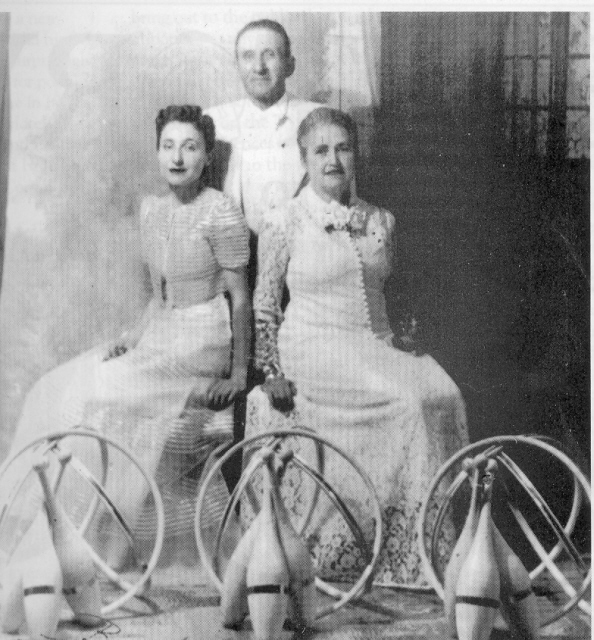
Clubs in the early days of Vaudeville, like those used by the de Koh Trio, could weigh as much as 23 ounces. |
Page 11 Summer 1997
|
You may wonder how I started the six-club juggle. Here's the way I got them in the air: Hold four clubs in the' right hand and two in the left, toss the two in left hand in the air (triple-turns), reach over and take one from the right hand, mix it in with the first two to do three in the left hand, and from there the three in the right hand start off on their merry journey through space. Six clubs in the air takes up quite a bit of room and if the clubs are not in their proper channels the only thing left to do is to hold your hands over your head in a protective manner and step out of the way of the cord of wood coming down at you.
The clubs used were regulation juggling clubs but were slightly smaller and much lighter than the type used for juggling in those days. In the old days when you ordered clubs from the wood turner you got the amount ordered but you couldn't depend on any uniformity of balance in the individual clubs. They would all be alike as to size, but more than likely some were knob heavy and others bottom heavy. We always ordered twice the amount that we needed in order to pick out enough clubs that would match for different tricks.
Without casting any reflections on the various club makers of those bygone days, I most sincerely believe that there were no perfect clubs made until Harry Lind got into the game of manufacturing them....
The clubs used today have a much greater life span than their ancestors of 40 years ago did. When we used to practice new tricks or freshen up on old ones we always went to a place where there was a nice bed of grass or a gym that had plenty of mats on the floor. A good bang on a hard floor would knock off the handle or split the club wide open. The handle of the club was attached to the neck only by a thin coat of glue. This weakness was remedied by Ed Van Wyck, who put a wooden nut on the inside end of the handle. That helped. Then Harry Lind came along with a much lighter contraption in the shape of a wedge, and presto, we have the club of today.
Today's clubs are many ounces lighter than the old ones, and much stronger. It takes a lot of banging to injure a modern club. They are made of stronger grained and well-selected woods, and the canvas cover, while not entirely new, is much lighter and still very strong. The manufacture of juggling clubs seems to have just about reached its peak of perfection. Jack Greene (Juggler's Bulletin #4, May 1948)
General difference between European and American juggling styles is that Europe puts the strong accents on technique and skill, U.S.A. on showmanship and fun. Here in Europe almost all great jugglers of today follow the so-called school of Rastelli, that is, they work with the "classic" objects - balls, rings, clubs, mouthstick, and balances and not cigar-boxes, hats, canes, little white balls, etc.
They wear the equally classic silk suit and hate smoking and tails. They are silent workers and would prefer to change their profession to speaking during their act. Dick Harris (Juggler's Bulletin #48, October 1948)
Two of our younger members, Bud Carlson and Stuart Raynolds, both students at Cornell University, were inspired by the Jugglers Convention last summer (where they first became acquainted) to get together a juggling act. Vi Carlson (Juggler's Bulletin #50, February 1949)
Had the pleasure of meeting Elizabeth Hanneford, head of the famous Hanneford family of riders. Six generations ago, in 1777, Ned Hanneford and John Scott competed as jugglers before George III. They started a family rivalry which went on for 113 years until Nana Scott married Ned Harineford IV. Betty Gotham (Juggler's Bulletin #50, February 1949) |

Clubs in the early days of Vaudeville, like those used by the de Koh Trio, could weigh as much as 23 ounces. |